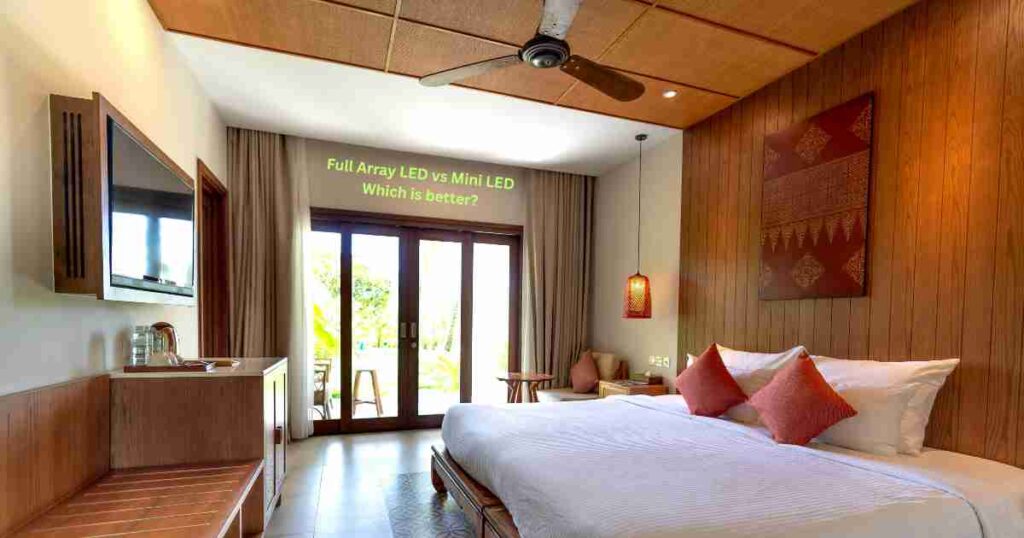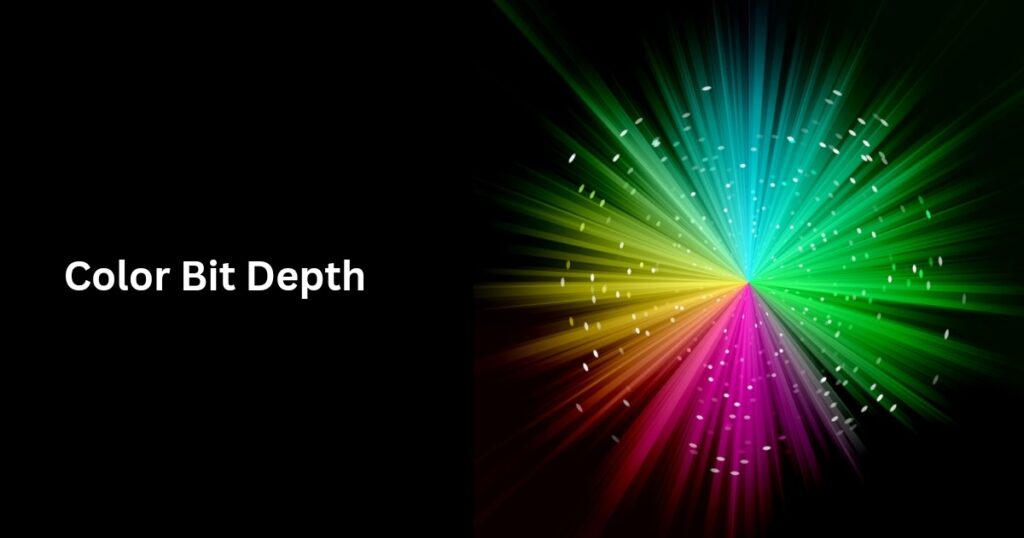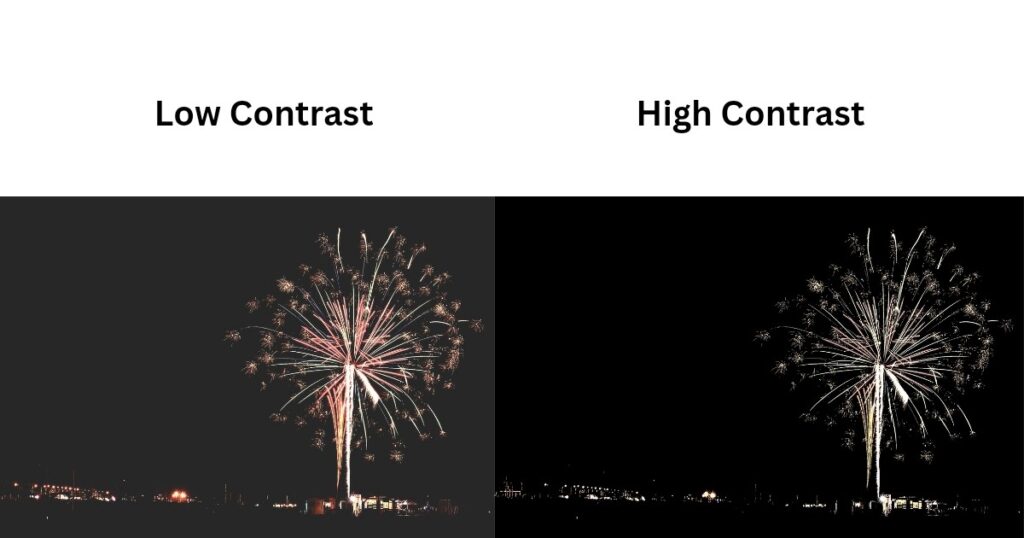
LCD TVs have been getting better over time, and a big part of that is thanks to local dimming tech.
You’ve probably seen terms like FALD, Full Array, or Mini LED and wondered which one’s the best.
In this article, we’ll break down what these technologies are and how they compare against each other.
What is a Full Array LED TV?
A full array LED TV is basically an LCD LED TV that has full array local dimming (FALD).
That means it has a bunch of LEDs spread out behind the entire screen, not just around the edges like in edge-lit TVs.
These LEDs are grouped into different zones, also called dimming zones—there can be anywhere from a few dozen to a few hundred of them.
When you’re watching something with a mix of dark and bright areas, the zones behind the darker parts can actually turn off completely, making those parts look really black.
This is a big step up from direct-lit TVs, where the LEDs are also behind the whole screen but can’t be dimmed at all.
So, dark scenes don’t look as good.
With FALD, you get deeper blacks and bright highlights at the same time, which means better contrast and a more realistic-looking picture.
What is a Mini LED TV?
A mini LED TV is pretty much like a full array TV, but with one key difference—the LEDs in the backlight are tiny, about one-fifth the size of the regular ones in full array TVs.
Because these mini LEDs are so small, there are way more of them compared to the bigger LEDs in full array TVs.
That leads to way more dimming zones—anywhere from a few hundred to even a few thousand.
This gives much nicer control over the dimming zones across the screen, significantly boosts contrast and makes blacks appear almost as deep as on OLEDs.
Full Array LED vs Mini LED TVs: Performance Comparison
Now that we’ve covered the basics of both, let’s dive into how they actually perform.
Contrast
Since the dimming zones can completely turn off behind darker parts of the screen, full array TVs are likely to have better contrast than regular LED TVs.
They also beat edge-lit TVs in contrast as the LEDs are spread across the entire backlight.
But, sometimes you might notice a little blooming.
Even in dark scenes, if there’s a bright spot, the LEDs behind it stay on, which can cause light to bleed into the darker areas.
This can make the blacks look more greyish or a bit raised in bright scenes.
“The more dimming zones a TV has, the better its contrast ratio tends to be.”
Mini LED TVs have way better contrast than full array TVs.
This is thanks to the huge number of dimming zones, allowing for super precise control over scenes.
In full array (FALD) TVs, the dimming zones are bigger, so if you have small objects that fall within those zones, they might look a bit blurry because the control isn’t as fine-tuned.
But with mini LED TVs, since the dimming zones are extremely tiny, the blacks are much deeper, and bright objects really pop and appear crisp and distinctly highlighted in dark scenes.
“The smaller the size of the dimming zone, the more precise the picture control.”
In high-end mini LED TVs, blooming is barely noticeable, and the black levels can even rival OLEDs.
Winner: Mini LED
Brightness
A full array LED TV can reach around 1000-2000 nits of brightness because its backlight LEDs can get pretty bright when needed.
It is brighter than edge-lit TVs, thanks to the LEDs spread all across its backlight.
Thus, it can handle glare and reflections to an extent, but it might not perform well in really bright rooms.
For example, if you’ve got a window open in front of the TV during the day, it may just show that window as a shadow.
On the other hand, mini LED TVs have thousands of tiny LEDs in their backlight, way more than the few hundred in a full array TV.
These mini LEDs can get insanely bright when needed—many models even hit over 4000 nits.
So, dealing with glare and reflections in a super bright room is usually a cup of tea for a mini LED TV.
Winner: Mini LED
HDR Performance
Mini LED TVs are much brighter than full array TVs, thus, with a wide color gamut and a large number of luminance levels, they can produce large color volumes.
With better contrast and a larger color volume, they offer an incredible HDR experience.
In bright rooms, the top mini LED models outperform most OLEDs when it comes to viewing in HDR.
The only OLEDs that can rival mini LEDs in such bright environments are the Samsung’s QD-OLEDs or the LG’s MLA-based OLEDs, thanks to their higher peak brightness.
Winner: Mini LED
Response
A mini LED TV, with its larger number of finer dimming zones, responds much faster than a full array TV.
It can respond in just 4-6 milliseconds, while a full array TV takes about 8-10 milliseconds.
This makes a huge difference in fast-paced games, where motion on a full array TV might get a little blurry, but on a mini LED, it stays pretty smooth.
That said, you might still notice some screen tearing during super-fast action scenes even on a mini LED.
If you want zero blur or tearing in any kind of content, though, an OLED TV is your best bet, as it responds in as quick as around 0.1 milliseconds.
Winner: Mini LED
Viewing Angles
Whether it’s a FALD or a mini LED TV, one with an IPS panel will give you better viewing angles compared to one with a VA panel.
Generally, high-end mini LED TVs, like Samsung’s Neo QLEDs, use VA panels because they offer a higher native contrast ratio, which is more important for HDR performance.
That being said, if you compare two VA panel TVs—one full array and one mini LED—the mini LED will have slightly better viewing angles.
This is probably because the mini LED’s backlight has a ton of dimming zones, giving it more precise control over different areas of the screen, which helps with overall image consistency from different angles.
However, the viewing angles in OLEDs are far better than those in mini LED TVs too.
Winner: Mini LED
Resolution
Both FALD and mini LED TVs come in 4K resolution, although many mini LED models also offer 8K resolution.
Since an 8K TV has four times the pixels of a 4K TV, it needs a lot of control over those pixels to maintain precise picture quality.
To achieve this, the TV needs a ton of dimming zones.
Mini LED TVs have thousands of smaller dimming zones compared to full array TVs, which gives them better control, even over tiny parts of the screen, though not quite good as individual control over each pixel as OLEDs.
This results in sharper, more detailed images and eye popping highlights on the 8K mini LED TVs.
Winner: Mini LED
Thickness
Full array TVs use regular-sized LEDs for their backlight, while mini LED TVs use super tiny LEDs.
Because of this, mini LED TVs are way thinner than full array ones. But even though they’re slim, mini LEDs still can’t match the ultra-thinness of OLEDs, since OLEDs don’t need a backlight at all!
Winner: Mini LED
Lifespan
Both full array and mini LED TVs are LCD-based, thus have inorganic pixels, so they don’t have the burn-in issues that can happen with OLEDs.
Plus, their pixels don’t degrade over time, giving them a long lifespan.
Winner: Both
Cost
One of the big factors to consider is the price.
Full array LED TVs tend to be pricier than edge-lit TVs but are still way more affordable than mini LED TVs.
That’s because fitting so many tiny LEDs into the backlight of a mini LED TV is lot more expensive than using regular LEDs in a full array TV.
Now, imagine the cost if each pixel needed its own LED—that’s what happens in a micro LED TV, and that’s when the price really skyrockets!
Winner: Full Array
FALD vs Mini LED TVs: Differences at a Glance
| Features | Full Array LED | Mini LED |
| Contrast | Good | Very good |
| Brightness | High | Very high |
| HDR Performance | Good | Superb |
| Response | Moderate | Fast |
| Viewing Angles | Moderate | Slightly better |
| Resolution | 4K | 4K and 8K |
| Thickness | Thicker | Slimmer |
| Lifespan | Very good | Very good |
| Average cost | $$$ | $$$$ |
Full Array LED vs Mini LED: Which is a better TV overall?
When comparing full array vs mini LED TVs, mini LED usually comes out on top in almost every feature.
But when it comes to buying, it really depends on your needs, how you watch, and your budget.
If you mostly watch in a dark room, enjoy a variety of content, and want deep, inky blacks and high contrast, an OLED is the way to go.
On the other hand, if you watch in a bright room and want a killer HDR experience without worrying about glare, along with bright highlights and deep blacks, a high-end mini LED TV is perfect for you.
That said, most of the full array TVs come cheaper than mini LEDs and OLEDs.
So if you’re looking to save some cash, a full array TV is still a solid choice—it’s a big step up from regular edge-lit LED TVs.
But if you’re eyeing a high-end full array TV that’s priced close to a budget mini LED, and the mini LED offers better features at the same price, it’s probably worth going for the mini LED TV.


